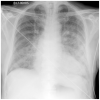Hemoptysis Due to Diffuse Alveolar Hemorrhage
- PMID: 37465227
- PMCID: PMC10332551
- DOI: 10.21980/J8ZP86
Hemoptysis Due to Diffuse Alveolar Hemorrhage
Abstract
Audience: This scenario was developed to educate junior and senior emergency medicine (EM) residents.
Introduction: EM Model of Practice recommends that the residents are able to manage patients in a critical condition from massive hemoptysis. Mild to moderate hemoptysis can be self-limiting and often can be managed with conservative measures; however, massive hemoptysis is a life-threatening emergency that needs to be managed promptly. Mortality from massive hemoptysis is about 13%-18%.1 There are several causes for hemoptysis ranging from pulmonary to vascular causes. Diffuse alveolar hemorrhage (DAH) causes hemoptysis only 0.2% which makes it a very rare but devastating disease.2 Hemoptysis from DAH can present a significant challenge to an EM physician since it can present in various ways including chest pain, shortness of breath or hemoptysis. Up to 40% of the patients can present without hemoptysis which makes it a diagnostic dilemma.3 Patients presenting with massive hemoptysis from DAH require management for hypovolemic shock, hypoxic respiratory arrest and potential cardiac arrest. The physicians also need to perform adequate ventilator management to help with alveolar recruitment. This simulation case can help discuss some of the nuances of the management of hemoptysis and DAH.
Objectives: By the end of this simulation session, learners will be able to: (1) recognize worsening respiratory status of a patient with hemoptysis and intervene appropriately, (2) manage a patient with severe hemoptysis and perform appropriate ventilator management, (3) manage sinus tachycardia with QT prolongation on the ECG caused by cocaine and hypomagnesemia, (4) address various etiologies of hemoptysis, (5) discuss the causes of massive hemoptysis and management options, and (6) review ventilation strategies in an intubated hypoxic patient.
Educational methods: This session was conducted using high-fidelity simulation, which was immediately followed by an in-depth debriefing session. Each session had 3 EM residents from various levels of training on the team and 7 observers. There was 1 simulation instructor running the session and 1 simulation technician who acted as a nurse.
Research methods: After the simulation and debriefing session was complete, an online survey was sent via surveymonkey.com to all the participants. The survey collected responses to the following questions: (1) the case was believable, (2) the case had right amount of complexity, (3) the case helped in improving medical knowledge and patient care, (4) the simulation environment gave me a real-life experience and, (5) the debriefing session after simulation helped improve my knowledge. A Likert scale was used to collect the responses.
Results: Seven learners responded to the survey. One hundred percent of them either agreed or strongly agreed that the case was beneficial in learning and improving patient care. They also agreed that it helped in improving medical knowledge. The post-session debrief was found to be very helpful by all the learners.
Discussion: High-fidelity simulation was a cost-effective yet realistic way to manage severe hemoptysis, PEA (pulseless electrical activity), and persistent hypoxia in patients with diffuse alveolar hemorrhage. Starting the case with severe hypoxia that quickly progresses to PEA helps the learner to manage the patient quickly and effectively. Overall, learners enjoyed managing the patient, followed by discussing the various management strategies.
Topics: Hemoptysis, diffuse alveolar hemorrhage, medical simulation, respiratory.
© 2020 Buchwald, et al.
Similar articles
-
Meningococcal Meningitis with Waterhouse-Friderichsen Syndrome.J Educ Teach Emerg Med. 2021 Jul 15;6(3):S1-S32. doi: 10.21980/J8TH1K. eCollection 2021 Jul. J Educ Teach Emerg Med. 2021. PMID: 37465078 Free PMC article.
-
Torsade de Pointes Due to Hypokalemia and Hypomagnesemia.J Educ Teach Emerg Med. 2022 Oct 15;7(4):S27-S51. doi: 10.21980/J8JP8G. eCollection 2022 Oct. J Educ Teach Emerg Med. 2022. PMID: 37465131 Free PMC article.
-
Alcohol Withdrawal with Delirium Tremens.J Educ Teach Emerg Med. 2023 Jul 31;8(3):S1-S33. doi: 10.21980/J8S35N. eCollection 2023 Jul. J Educ Teach Emerg Med. 2023. PMID: 37575406 Free PMC article.
-
Granulomatosis With Polyangiitis Presenting With Diffuse Alveolar Hemorrhage: A Systematic Review.Cureus. 2022 Oct 4;14(10):e29909. doi: 10.7759/cureus.29909. eCollection 2022 Oct. Cureus. 2022. PMID: 36348918 Free PMC article. Review.
-
Diffuse alveolar hemorrhage and systemic lupus erythematosus. Clinical presentation, histology, survival, and outcome.Medicine (Baltimore). 1997 May;76(3):192-202. doi: 10.1097/00005792-199705000-00005. Medicine (Baltimore). 1997. PMID: 9193454 Review.
References
-
- Pollack CV. Differential Diagnosis of Cardiopulmonary Disease: a Handbook. Cham: Springer; 2019. Hemoptysis; pp. 495–496.
-
- Radchenko C, Alraiyes AH, Shojaee S.A systematic approach to the management of massive hemoptysis. Journal of Thoracic Disease. [Accessed March 19, 2020]. https://www.ncbi.nlm.nih.gov/pmc/articles/PMC5696556/. Published September 2017. - PMC - PubMed






